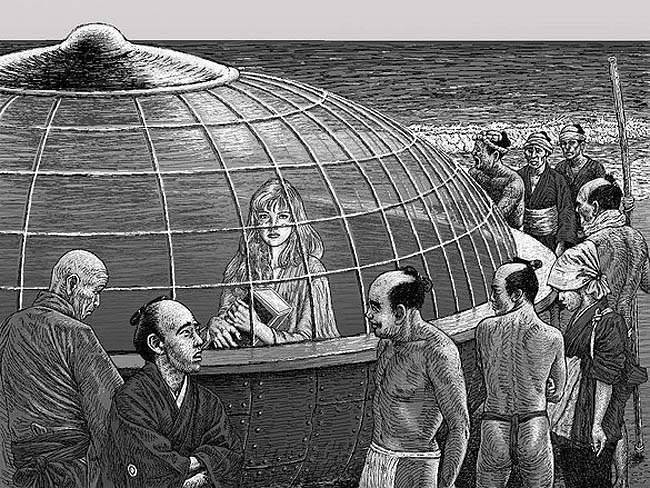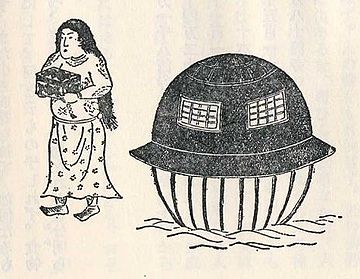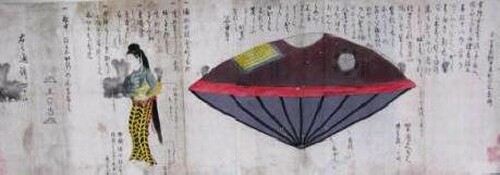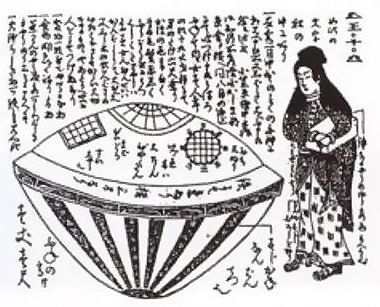
|
|||
The Mysterious Case Of the Utsuro-Bune and Alien Woman
Source : http://en.wikipedia.org/wiki/Utsuro-bune
Japan-1803 One of the first modern UFO stories comes from Japan. This is the story of Utsuro-Bune, a mysterious alien woman who appeared suddenly from the depths of the Pacific Ocean on a round ship. A detailed study of paintings from the era of the Utsuru-Bune reveals an object that resembles a flying saucer, similar to those seen today. A pale, redheaded woman was inside the ship, wearing soft, light clothing clutching a box. Where did she come from? What was in the box? Nobody knows. A pale, redheaded woman was inside the ship, clutching a wooden box close to her. When she spoke, it was in a language that no Japanese person had ever heard before. What language was she speaking? Where did she come from? What was in the box? Nobody knows for sure. What makes things even weirder is that this same woman and craft were reported to have visited many different parts of Japan. People from all over Japan described having seen the exact same woman in the exact same ship, still tightly holding her wooden box UFO enthusiasts might tell you that this particular story is plausible. The Bermuda Triangle’s sister, the Dragon’s Triangle (also known as the Devil’s Triangle), is a “danger zone” in the sea off the Southern coast of Japan. A large amount of boats have gone missing there along with 800+ people, never to be seen again. Some people believe that both the Bermuda and Dragon’s Triangle are actually where aliens have set up underwater bases (because it’s tough for us to find them there). Boats that make their way into alien territory aren’t guaranteed to make it through. Some would say that the Utsuro bune came from this “Dragon’s Triangle.” Who really knows, though? Tales Of Castaways In a book repository in Japan, there’s a document dating back to the 1800s called “Tales of Castaways.” In it, there’s a strange story about usturso bune, or “hollow ship.” It describes an incident in which a 3 meter by 5 meter round, metal ship with crystal windows washed up onto a Japanese beach in modern day Ibaraki prefecture. Inside the ship was writing in a language the Japanese had never seen before.
The story covers the period known as Tokugawa (between 1603 and 1867) when Japan was kept completely isolated from the rest of the world, living in a feudal society entirely (the shogunate) and avoiding any foreign influence, especially the West. It is not uncommon for the presence of "someone who came from afar" (a foreigner) was sufficient cause to produce a movement in people who, either for or against the Nippon isolation, I record the time when many writings and drawings. Kasuo tanaka is a professor at Gifu University in Tokyo, and was the one who revived the legend of Utsuro-bune in 1997. His research focuses if the mysterious woman who left the waters of the Pacific many years ago was actually part of the close encounter of a 3 rd type (name with which you define the type of encounter with extraterrestrial intelligence). The investigation was thorough and after studying all the existing buildings in the period of 200 years ago in the area and could not find any similar to this (to have been a common type of ship would not have done so much emphasis on form and in the internal details).  An old man from the village said, "This woman could be a princess of a foreign realm, who married at her homeland. But when she had an affair with a townsman after marriage, it caused a scandal and the lover was killed for punishment. The princess was banned from home, for she enjoyed lots of sympathy, so she escaped the death penalty. Instead she might have been exposed in that Utsuro-bune to leave her to destiny. If this should be correct, the quadratic box may contain the head of the woman's deceased lover. In the past, a very similar object with a woman was washed ashore on a close-by beach. During this incident a small board with a pinned head was found. The content of the box could therefore be the same, which would certainly explain why she protects it so much. It would afford lots of money and time to investigate the woman and her boat. Since it seems to be tradition to expose those boats at sea, we should bring the woman back to the Utsuro-bune and let her drift away. From human sight it might be cruel, but it seems to be her predetermined destiny." The fishermen reassembled the Utsuro-bune, placed the woman in it, and set it to drift away into the ocean Ume no chiri On March 24 in 1803, at the beach of 'Harato-no-hama' in the Hitachi province, a strange 'boat' was washed ashore. It reminded the witnesses of a rice cooking pot, around its middle it had a thickened rim. It was also coated with black paint and it had four little windows on four sides. The windows had bars and they were clogged with tree resin. The lower part of the boat was protected by brazen plates which looked to be made of iron of the highest western quality. The height of the boat was 131,1 inches and its breadth was 212,9 inches. A woman of 20 years was found in the boat. Her body size was 4,92 feet and her skin was white as snow. The long hair dangled smoothly down along her back. Her face was of indescribable beauty. The dress of the woman was of unknown style and no one could recognise it. She spoke an unknown language. She held a small box no one was allowed to touch. Inside the boat two unusually soft carpets of unknown style and fabric were found. There were supplies such as cake, kneaded food and meat. A beautiful decorated cup with ornaments no one could identify was also found. Similar traditions There are several further documents about Utsuro-bune sightings in Japan, for example 'Hirokata Zuihitsu' and 'Oshu Kuzakki' In 2010 and 2012 two rare ink printings were found and investigated by Kazuo Tanaka. They contained stories about Utsuro-bune with very similar content to that of the Hyoryu kishu, although they claim a different location for the events: 'Minato Boshu' A well known Japanese legend is that of the origin of the Kawano dynasty. In the 7th century, a fisherman named 'Wakegoro' from Gogo island found a 13-year old girl inside a Utsuro-bune drifting at sea. He brought her to land, where she told him that she was the daughter of the Chinese emperor and that she had been forced to flee to escape her stepmother. The fisherman named her 'Wake-hime' ('princess Wake') and raised her, before she married an imperial prince of Iyo province and gave birth to a son named 'Ochimiko' , the ancestor of the Kawano dynasty. A part of this folk tale held that she was responsible for bringing the first silk cocoons to Japan. Princess Wake is still worshipped at a certain Shinto shrine in the village of Funakoshi, Go-Go islan Interpretations  Ink drawing of the Utsuro-bune by Kyokutei Bakin (1825). Historical investigations The first historical investigations of the Utsuro-bune incident were conducted in 1844 by Kyokutei Bakin (1767–1848). Kyokutei reports about a book called Roshia bunkenroku 'Records of seen and heard things from Russia'?), written by Kanamori Kinken. The book describes traditional Russian clothes and hairstyles and mentions a popular method to dust hair with white powder. It also mentions that many Russian woman have natural red hair and that they wear skirts, similar to that of the lady of the legend. Based upon the book, Kyokutei concludes that the woman of the Utsuro-bune incident could have been of Russian origin. He writes that the stories are similar to each other, as they differ only in minor descriptions (for example, one documents says "3.6 litres of water", another says "36 litres of water"). He also questions the origin of the alleged exotic symbols found in and on the boat. Because he is convinced that he saw similar signs on a British whaler stranded shortly before his writing, Kyokutei wonders if the woman was a Russian, British or even American princess. Furthermore he expresses his disappointment about the drawings of the Utsuro-bune, because they obviously do not fully match the witness descriptions. Modern investigations Further investigations of the Utsuro-bune incident were done in 1925 and in 1962 by ethnologist and historian Yanagida Kunio. He points out that circular boats were never anything unusual in Japan since early times; only the western-like details, such as the windows made of glass and the brazen protective plates, make the Utsuro-bune look exotic. He also found out that most legends similar to that of the Utsuro-bune sound alike: Someone finds a strange girl or young woman inside a circular boat and rescues the stranded or sends her back to the ocean. Yanagida also points out that the eldest versions of Utsuro-bune describe humble, circular and open log-boats without any dome atop. Yanagida assumes that the details of the brazen plates and windows made of glass or crystal were added because sceptics would question the seaworthiness of a humble log-boat on the high seas. A steel reinforced Utsuro-bune with glass windows would more easily survive travelling on the ocean than a humble log-boat. Dr. Kazuo Tanaka Japanese professor for computer and electronics engineering from Gifu University at Tokyo , investigated the original scripts in 1997. He considers the popular comparisons of the Utsuro-bune with modern UFO sightings to be far-fetched. He points out that the Utsuro-bune of the legends never flies or moves on its own, nor does it show any signs of extraordinary technologies. It simply drifts motionless on the water. Tanaka concludes that the tale of the Utsuro-bune was a literary mixture of folklore and imaginations. He bases his assumptions on the 1925 investigations of the Japanese historian Yanagida Kunio, who had also studied the tales of the Utsuro-bune. Dr. Tanaka himself found out that the locations "Haratono-hama" and "Harayadori" are fictitious. To make the anecdote sound credible, the author designated the beaches as personal acreages of a Daimyo named Ogasawara Nagashige. This daimyo actually lived during the Edo period, but his acreages were placed at heartland and it seems sure that Ogasawara never had any contact with the fishermen of the Pacific coast. The Ogasawara clan served the famous Tokugawa dynasty, who held power over the most north-eastern part of Japan until 1868 and their main acreages were placed in the Hitashi province, geographically very close to the eastern beaches. Tanaka finds it very odd that no incident of such alleged importance was commented on in the curatorial documents, since strangers leaving the shore had to be reported at once. But the only remarkable incident during the late Tokugawa dynasty happened in 1824, when a British whaler was stranded at the north-eastern coast of the Hitachi district. Tanaka also found out that, during the rulership of the Tokugawa clan, the Ogasawara family and the Tokugawa started mapping their territories and acreages. And both names of "Haratono-hama" and "Harayadori" are missing. They also do not appear on the maps of the first complete mappings of whole of Japan in 1907. If the name of a village, city or place had changed in history, this would have been noted in some curatorial documents, but it is not. Tanaka thinks it rather unlikely that important places such as "Haratono-hama" and "Harayadori" actually could have been forgotten in records. The peculiar European appearance of the woman, the upper part of the Utsuro-bune and the unknown writings lead Tanaka and Yanagida to the conclusion that the whole story was based on the historical circumstance that people of the Edo period totally encapsulated Japan against the outer world. To bedizen a stranded woman with European attributes showed how much the peoples were afraid of bad cultural influences from the western world, especially North America and Great Britain. The story of the Utsuro-bune is significantly constructed in a way that makes the tale sound incredible at one site, but self-explaining at the same time (the woman and her craft are sent away so no one could ever consult her personal).  Furthermore Tanaka and Yanagida point out, that the people of Edo period shared great interests in paranormal things such as poltergeists, will-o'-the-wisps, ball lightnings and monsters, so it would not be surprising to find stories of exotic boats like the Utsuro-bune. In his conclusions, Tanaka points to the difficulty in the correct reading of the place names. In modern transcriptions, the Kanji have to be read as Harasha. But in Toen Shosetsu the signs are written in Kana and they have to be read as Hara-yadori. In Ume no chiri they are written in Furigana making the place to be named as Haratono-hama. Alternatively, the kanji for Haratono could be read as Hara-yadori. According to Tanaka’s investigations, the transcription of in the Hyoryu Kishu as "Harasha-ga-hama" is therefore a typo based on a misreading and should originally be read as "Haratono-ga-hama". Thus, all writings describe the same place. Tanaka also points out that the word Utsuro means "empty" or "abandoned" and that the word Utsubo means "quiver" and describes the bags in which hunters and archers once carried their arrows. But both words also describe old, hollowed tree trunks and branch holes of sacred trees. The word Fune/Bune simply means "boat". Altogether, the word Utsuro-bune means "hollow ship". Ufological In Ufology, the legend of the Utsuro-bune has been described as an early case of a documented close encounter of the third kind, something based upon alleged similarities between the drawings of the vessel from the Edo period and 20th century descriptions of flying saucers. Some Ufologists think that the Utsuro-bune could have been some kind of unidentified submarine object (USO). In addition UFO-believers point to the mysterious symbols which were allegedly found on the object and which regularly appear as addenda within the depictions. They are said to show stunning similarities to the symbols seen at the Rendlesham Forest Incident in England. Furthermore Ufo-believers point to the ominous box, which was jealously guarded by the woman. They suspect the box to be some kind of extraterrestrial device. Finally, they discuss about the appearance of the woman and her unusual dress. The assumptions of any historian and ethnologist about those items are repeatedly ignored. Submit News/Videos/Links | Discuss article | Article Link | More Unsolved and Unexplained Mysteries |
More can be addded on request. Direct your requests at vinit@theunexplainedmysteries.com
